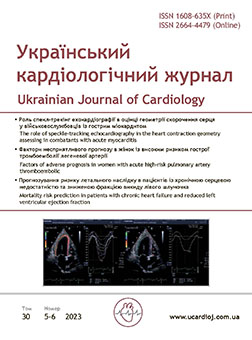Own experience of neural analysis in predicting long-term survival of patients with chronic heart failure
Main Article Content
Abstract
The aim – predicting the risk of fatal outcome within 3 years in patients with CHF and reduced left ventricular ejection fraction (LVEF) with neural network.
Materials and methods. The retrospective analysis of 490 medical histories of patients who were hospitalized in the heart failure department between 2011 and 2018 years with CHF II–IV functional class according to NYHA with LVEF ≤ 40 % on the background of coronary heart disease was conducted. Patients with clinical signs of heart failure II NYHA functional class – 455 (92.8 %) patients and with clinical signs of CHF III NYHA functional class – 35 (7.2 %) patients. The analysis was conducted for 490 patients: 228 (46.5 %) patients had a fatal event within three years, 262 (53.5 %) patients survived three years.
Results and discussion. Factor features was selected for building a neural network. The information about 8 factor characteristics (ACE inhibitor (X1), atrium fibrillation (X2), renal dysfunction (X3), age (X4), arterial pressure (X5), (X6), LV diastolic volume index ( X7), LV myocardial mass index (X8)) was used for building of neural network models. Three-layer Multiplayer Perceptron (MLP) model with one hidden layer (logistic activation function) was built in the final. This neural network is a type of multi-layer neural network (multi-network perceptron). Each neuron of this system uses a nonlinear activation function. The sensitivity and specificity of this neural network model was evaluated. The education of this neural network did by the method of backpropagation. The quality of the classification of this model was evaluated with the test set of cases. The area under the curve of the operating characteristics of the neural MLP model for predicting the risk of a fatal event exceeds that area of the 9-factor logistic regression model (p<0.001).
Conclusions. The use of neural network analysis increase the accuracy of predicting a fatal outcome for a 3-year period compared to a multifactor logistic regression model. According to the construction of the neural network MLP model, a strong connection of the risk of a fatal event over the course of 3 years with the presence of atrium fibrillation, renal dysfunction, age, LV diastolic volume index, LV myocardial mass index and ACE inhibitor in the treatment was revealed. The quality of the neural network MLP model is high (area under the curve AUC=0.842). Youden Index (Ycrit=0.3049), the sensitivity of the MLP model is 76.8 % (95 % CI 70.7–82.1 %), the specificity of the model is 81.3 % (95 % CI 76.0–85.8 %), predictive significance +PV – 78.1 % (95 % CI 73.3–82.3 %), predictive significance –PV – 80.1 % (95 % CI 75.9–83.7 %). The accuracy of predicting the risk of a fatal outcome within 3 years for the neural network MLP model is higher than for the 9-factor logistic regression model (р<0.001).
Article Details
Keywords:
References
Voronkov LG. [Chronic cardiac failure in elderly patients]. Circulation and haemostasis. 2013;3-4:107-11. Ukrainian.
Nahorna NV, Konopko MM, Hurianov VH. Bilsh znachushchi faktory ryzyku rozvitku dylatatsii porozhnyn sertsia u patsiientiv z ekstrasystoliieiu. Klinichna pediatriia. 2012;1:51-4. Ukrainian.
Amari SI. The Brain and Computer. Proceedings of 1993 International Joint Conference on Neural Networks; 1993 October 25-29; Nagoya, Japan. Nagoya; 1993. 1:7-8.
Baxt WG. Complexity, chaos and human physiology: the justification for non-linear neural computational analysis. Cancer Lett. 1994;77(2-3):85-93.
Becraft WR. Diagnostic applications of artificial neural networks. Proceedings of 1993 International Joint Conference on Neural Networks; 1993 October 25-29; Nagoya, Japan. Nagoya; 1993. 2:2807-10.
Boeldt DL, Wineinger NE, Waalen J, Gollamudi S, Grossberg A, Steinhubl SR, McCollister-Slipp A, Rogers MA, Silvers C, Topol EJ. How consumers and physicians view new medical technology: comparative survey. J Med Internet Res. 2015 Sep 14;17(9):e215. https://doi.org/10.2196/jmir.4456.
Cagnoni S, Coppini G, Rucci M, Caramella D, Valli G. Neural network segmentation of magnetic resonance spin echo images of the brain. J Biomed Eng. 1993 Sep;15(5):355-62. https://doi.org/10.1016/0141-5425(93)90071-6.
Caterini AL, Chang DE. Recurrent neural networks. Springer Briefs Comput Sci. 2018;59-79.
Fu HC, Shann JJ. A fuzzy neural network for knowledge learning. IInt J Neural Syst. 1994 Mar;5(1):13-22. https://doi.org/10.1142/s0129065794000037.
Gabriel G, Schizas CN, Pattichis CS, et al. Qualitative Morphological Analysis of Muscle Biopsies Using Neural Networks. 1993 October 25-29; Nagoya, Japan. Nagoya; 1993. 1:943-6.
Hilledge HL, Girbers AR, de Kam PJ, Boomsma F, de Zeeuw D, Charlesworyh A, Hampton JR, van Veldhuisein DJ. Renal function, neurohormonal activation, and survival in patients with chronic heart failure. 2000 Jul 11;102(2):203-10. https://doi.org/10.1161/01.cir.102.2.203.
Hsu W, Hsu LS, Tenorio MF. The ClusNet algorithm and time series prediction. Int J Neural Syst. 1993 Sep;4(3):247-55. https://doi.org/10.1142/s0129065793000201.
Konstam MA, Hill JA, Kovacs RJ, Harrington RA, Arrighi JA, Khera A; Academic Cardiology Section Leadership Council of the American College of Cardiology. The academic medical system: reinvention to survive the revolution in health care. J Am Coll Cardiol. 2017 Mar 14;69(10):1305-12. https://doi.org/10.1016/j.jacc.2016.12.024.
Milletari F, Navab N, Ahmadi SA. V-Net: Fully convolutional neural networks for volumetric medical image segmentation. 2016, Fourth International Conference on 3D Vision (3DV).
Ronneberger O, Fischer P, Brox T. U-net: Convolutional networks for biomedical image segmentation. Lect Notes Comput Sci. 2015;9351 234-41.
Rozenbojm J, Palladino E, Azevedo AC. An expert clinical diagnosis system for the support of the primary consultation. Salud Publica Mex. 1993;35(3):321-5.
Shameer K, Badgeley MA, Miotto R, Glicksberg BS, Morgan JW, Dudley JT. Translational bioinformatics in the era of real-time biomedical, health care and wellness data streams. Brief Bioinform. 2017;18:105-24.
Shelhamer E, Long J, Darrell T. Fully сonvolutional networks for semantic segmentation. IEEE Trans Pattern Anal Mach Intell. 2017;39(4):640-51. https://doi.org/10.1109/TPAMI.2016.2572683.
Steinhubl SR, Topol EJ. Moving from digitalization to digitization in cardiovascular care: why is it important, and what could it mean for patients and providers? J Am Coll Cardiol. 2015;66:1489-96.
Szegedy C, Toshev A, Erhan D. Deep Neural Networks for object detection. Adv Neural Inf Process Syst. 2013;2553-61.
Todd BS, Stamper R, Macpherson P. A probabilistic rule-based expert system. Int J Biomed Comput. 1993;33(2):129-48.


